Elaborating Various Sectors and Examination of Different Scales
VerifiedAdded on 2022/11/28
|16
|4685
|329
AI Summary
This article discusses the various sectors in business and examines the different scales of companies. It evaluates the advantages and disadvantages of different types of companies and their organizational structures. The content also explores the interrelationships between functional departments in a company.
Contribute Materials
Your contribution can guide someone’s learning journey. Share your
documents today.
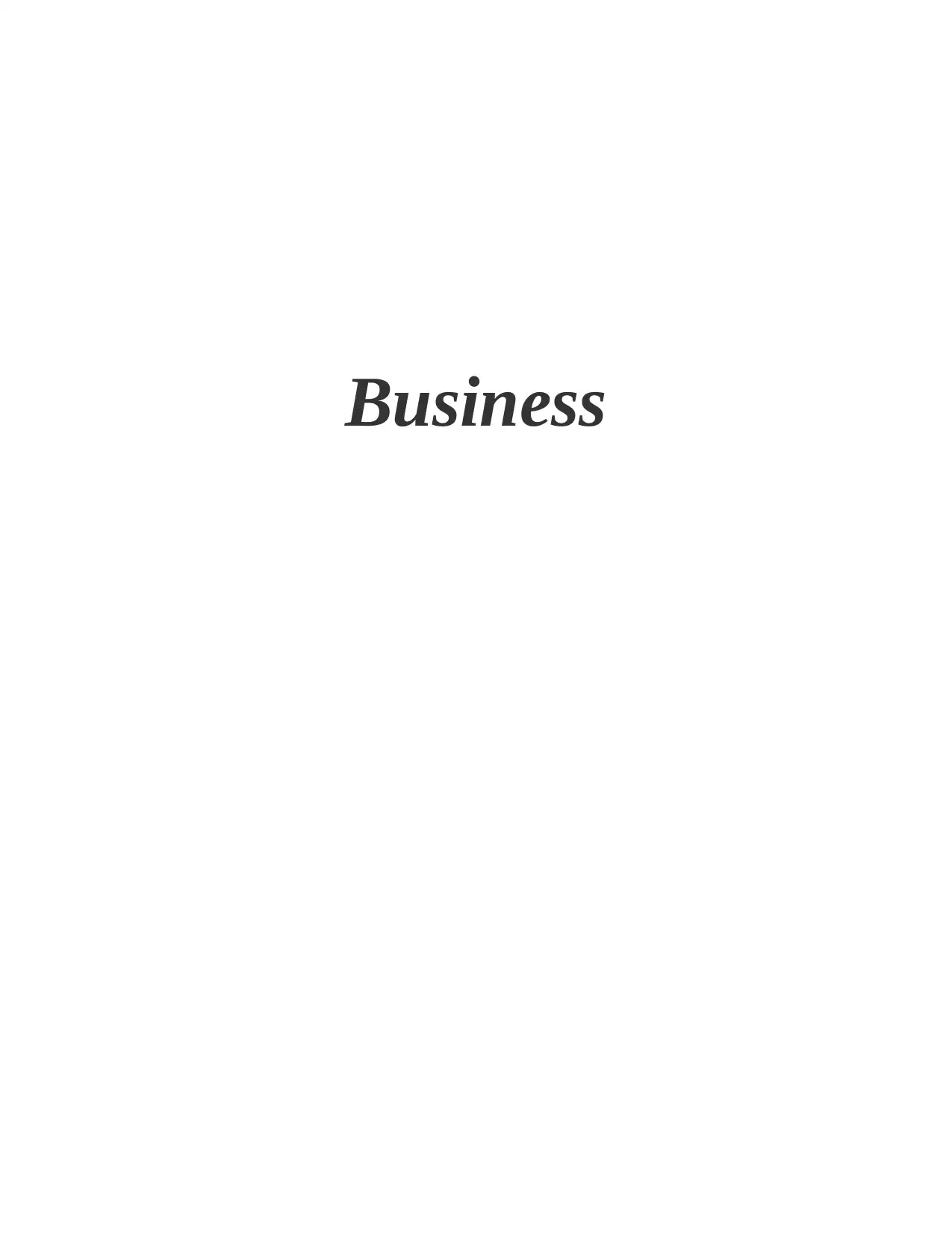
Business
Secure Best Marks with AI Grader
Need help grading? Try our AI Grader for instant feedback on your assignments.
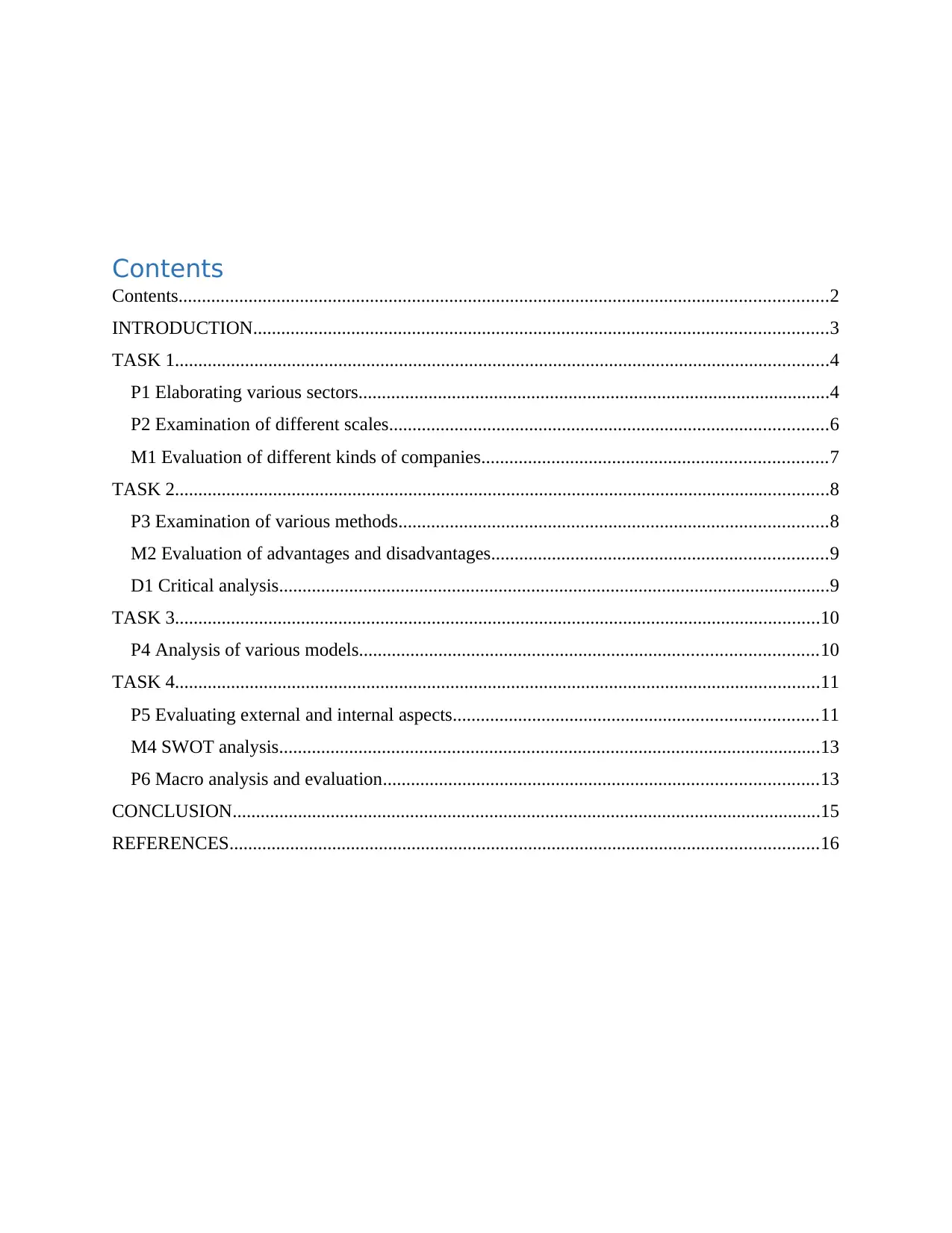
Contents
Contents...........................................................................................................................................2
INTRODUCTION...........................................................................................................................3
TASK 1............................................................................................................................................4
P1 Elaborating various sectors.....................................................................................................4
P2 Examination of different scales..............................................................................................6
M1 Evaluation of different kinds of companies..........................................................................7
TASK 2............................................................................................................................................8
P3 Examination of various methods............................................................................................8
M2 Evaluation of advantages and disadvantages........................................................................9
D1 Critical analysis......................................................................................................................9
TASK 3..........................................................................................................................................10
P4 Analysis of various models..................................................................................................10
TASK 4..........................................................................................................................................11
P5 Evaluating external and internal aspects..............................................................................11
M4 SWOT analysis....................................................................................................................13
P6 Macro analysis and evaluation.............................................................................................13
CONCLUSION..............................................................................................................................15
REFERENCES..............................................................................................................................16
Contents...........................................................................................................................................2
INTRODUCTION...........................................................................................................................3
TASK 1............................................................................................................................................4
P1 Elaborating various sectors.....................................................................................................4
P2 Examination of different scales..............................................................................................6
M1 Evaluation of different kinds of companies..........................................................................7
TASK 2............................................................................................................................................8
P3 Examination of various methods............................................................................................8
M2 Evaluation of advantages and disadvantages........................................................................9
D1 Critical analysis......................................................................................................................9
TASK 3..........................................................................................................................................10
P4 Analysis of various models..................................................................................................10
TASK 4..........................................................................................................................................11
P5 Evaluating external and internal aspects..............................................................................11
M4 SWOT analysis....................................................................................................................13
P6 Macro analysis and evaluation.............................................................................................13
CONCLUSION..............................................................................................................................15
REFERENCES..............................................................................................................................16
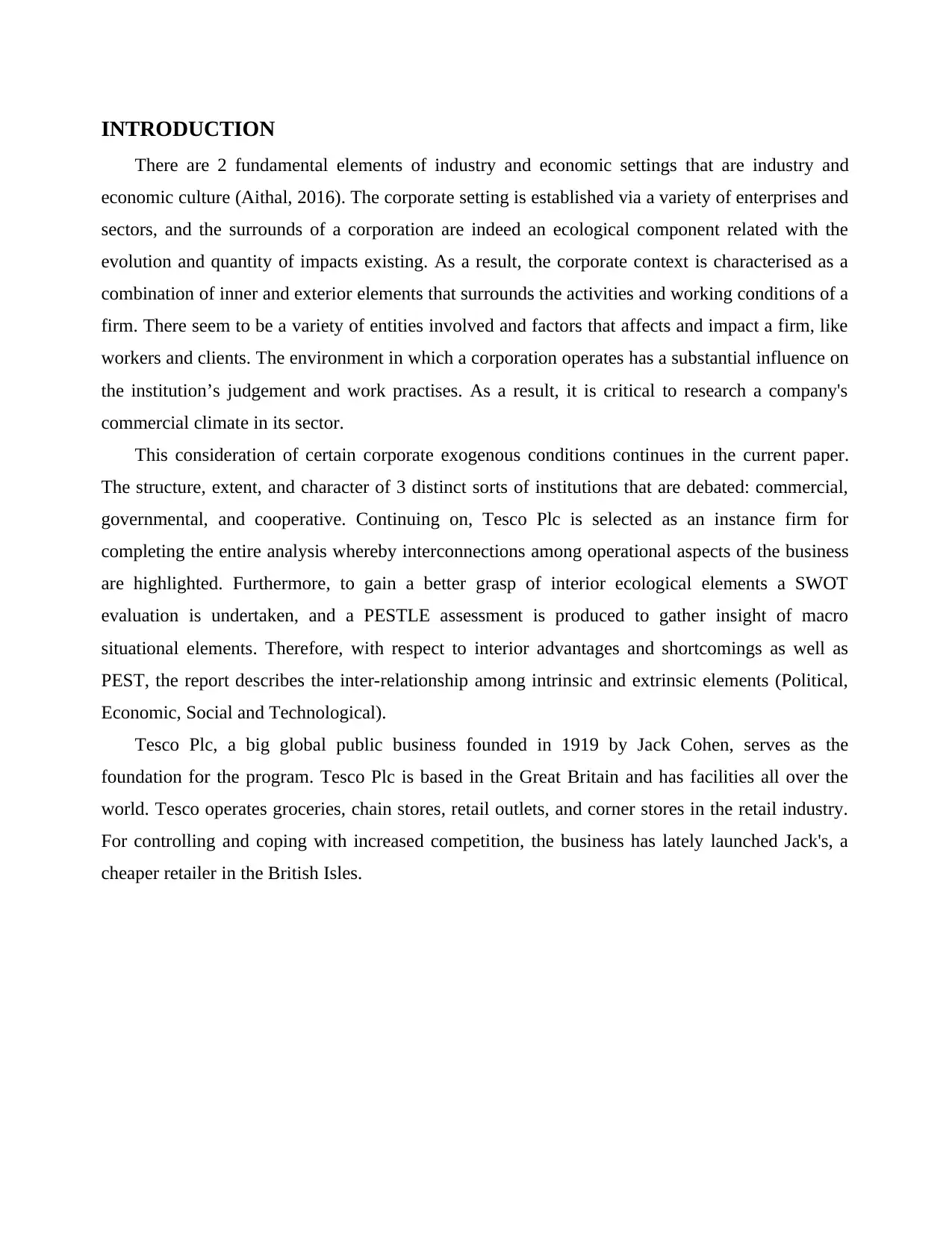
INTRODUCTION
There are 2 fundamental elements of industry and economic settings that are industry and
economic culture (Aithal, 2016). The corporate setting is established via a variety of enterprises and
sectors, and the surrounds of a corporation are indeed an ecological component related with the
evolution and quantity of impacts existing. As a result, the corporate context is characterised as a
combination of inner and exterior elements that surrounds the activities and working conditions of a
firm. There seem to be a variety of entities involved and factors that affects and impact a firm, like
workers and clients. The environment in which a corporation operates has a substantial influence on
the institution’s judgement and work practises. As a result, it is critical to research a company's
commercial climate in its sector.
This consideration of certain corporate exogenous conditions continues in the current paper.
The structure, extent, and character of 3 distinct sorts of institutions that are debated: commercial,
governmental, and cooperative. Continuing on, Tesco Plc is selected as an instance firm for
completing the entire analysis whereby interconnections among operational aspects of the business
are highlighted. Furthermore, to gain a better grasp of interior ecological elements a SWOT
evaluation is undertaken, and a PESTLE assessment is produced to gather insight of macro
situational elements. Therefore, with respect to interior advantages and shortcomings as well as
PEST, the report describes the inter-relationship among intrinsic and extrinsic elements (Political,
Economic, Social and Technological).
Tesco Plc, a big global public business founded in 1919 by Jack Cohen, serves as the
foundation for the program. Tesco Plc is based in the Great Britain and has facilities all over the
world. Tesco operates groceries, chain stores, retail outlets, and corner stores in the retail industry.
For controlling and coping with increased competition, the business has lately launched Jack's, a
cheaper retailer in the British Isles.
There are 2 fundamental elements of industry and economic settings that are industry and
economic culture (Aithal, 2016). The corporate setting is established via a variety of enterprises and
sectors, and the surrounds of a corporation are indeed an ecological component related with the
evolution and quantity of impacts existing. As a result, the corporate context is characterised as a
combination of inner and exterior elements that surrounds the activities and working conditions of a
firm. There seem to be a variety of entities involved and factors that affects and impact a firm, like
workers and clients. The environment in which a corporation operates has a substantial influence on
the institution’s judgement and work practises. As a result, it is critical to research a company's
commercial climate in its sector.
This consideration of certain corporate exogenous conditions continues in the current paper.
The structure, extent, and character of 3 distinct sorts of institutions that are debated: commercial,
governmental, and cooperative. Continuing on, Tesco Plc is selected as an instance firm for
completing the entire analysis whereby interconnections among operational aspects of the business
are highlighted. Furthermore, to gain a better grasp of interior ecological elements a SWOT
evaluation is undertaken, and a PESTLE assessment is produced to gather insight of macro
situational elements. Therefore, with respect to interior advantages and shortcomings as well as
PEST, the report describes the inter-relationship among intrinsic and extrinsic elements (Political,
Economic, Social and Technological).
Tesco Plc, a big global public business founded in 1919 by Jack Cohen, serves as the
foundation for the program. Tesco Plc is based in the Great Britain and has facilities all over the
world. Tesco operates groceries, chain stores, retail outlets, and corner stores in the retail industry.
For controlling and coping with increased competition, the business has lately launched Jack's, a
cheaper retailer in the British Isles.
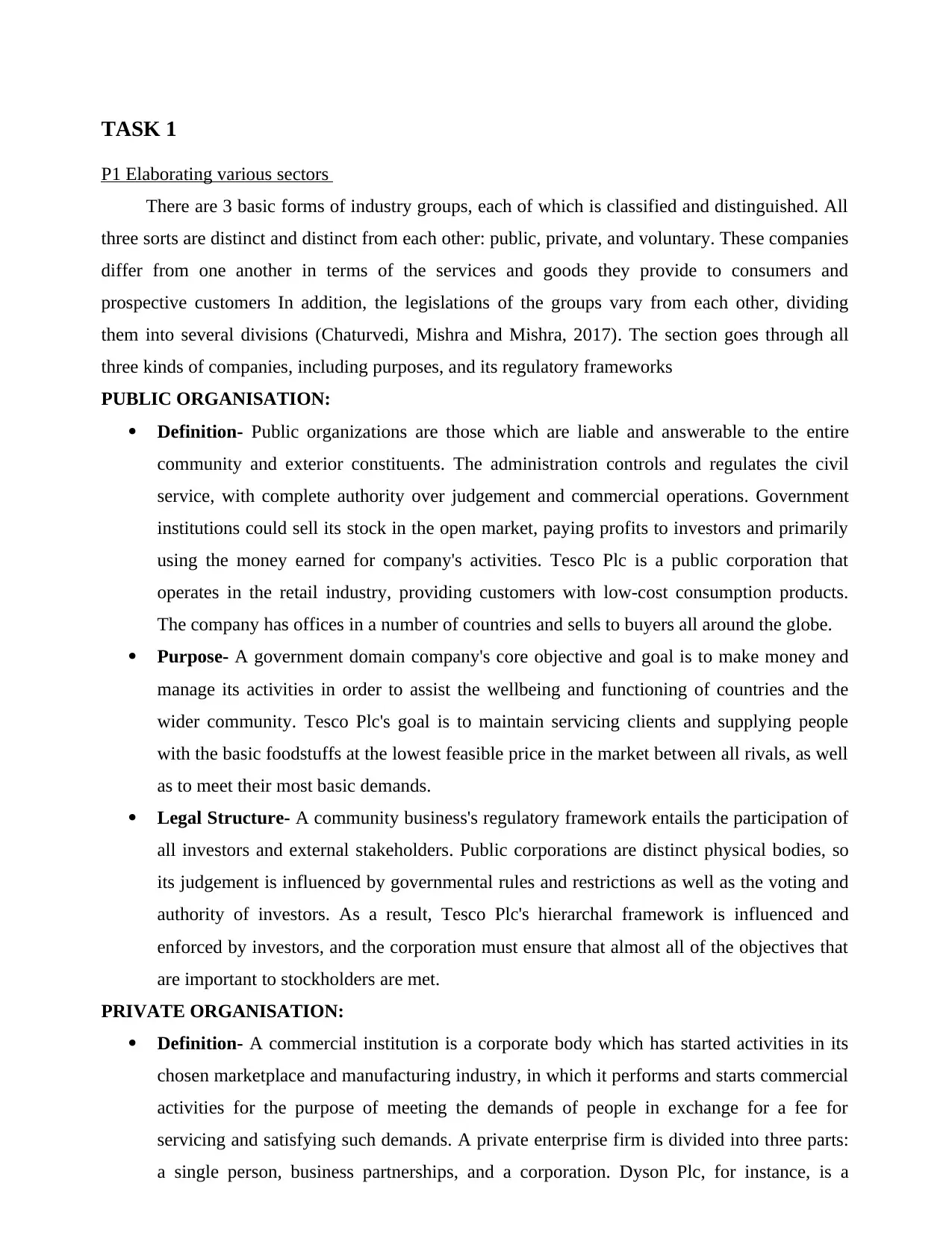
TASK 1
P1 Elaborating various sectors
There are 3 basic forms of industry groups, each of which is classified and distinguished. All
three sorts are distinct and distinct from each other: public, private, and voluntary. These companies
differ from one another in terms of the services and goods they provide to consumers and
prospective customers In addition, the legislations of the groups vary from each other, dividing
them into several divisions (Chaturvedi, Mishra and Mishra, 2017). The section goes through all
three kinds of companies, including purposes, and its regulatory frameworks
PUBLIC ORGANISATION:
Definition- Public organizations are those which are liable and answerable to the entire
community and exterior constituents. The administration controls and regulates the civil
service, with complete authority over judgement and commercial operations. Government
institutions could sell its stock in the open market, paying profits to investors and primarily
using the money earned for company's activities. Tesco Plc is a public corporation that
operates in the retail industry, providing customers with low-cost consumption products.
The company has offices in a number of countries and sells to buyers all around the globe.
Purpose- A government domain company's core objective and goal is to make money and
manage its activities in order to assist the wellbeing and functioning of countries and the
wider community. Tesco Plc's goal is to maintain servicing clients and supplying people
with the basic foodstuffs at the lowest feasible price in the market between all rivals, as well
as to meet their most basic demands.
Legal Structure- A community business's regulatory framework entails the participation of
all investors and external stakeholders. Public corporations are distinct physical bodies, so
its judgement is influenced by governmental rules and restrictions as well as the voting and
authority of investors. As a result, Tesco Plc's hierarchal framework is influenced and
enforced by investors, and the corporation must ensure that almost all of the objectives that
are important to stockholders are met.
PRIVATE ORGANISATION:
Definition- A commercial institution is a corporate body which has started activities in its
chosen marketplace and manufacturing industry, in which it performs and starts commercial
activities for the purpose of meeting the demands of people in exchange for a fee for
servicing and satisfying such demands. A private enterprise firm is divided into three parts:
a single person, business partnerships, and a corporation. Dyson Plc, for instance, is a
P1 Elaborating various sectors
There are 3 basic forms of industry groups, each of which is classified and distinguished. All
three sorts are distinct and distinct from each other: public, private, and voluntary. These companies
differ from one another in terms of the services and goods they provide to consumers and
prospective customers In addition, the legislations of the groups vary from each other, dividing
them into several divisions (Chaturvedi, Mishra and Mishra, 2017). The section goes through all
three kinds of companies, including purposes, and its regulatory frameworks
PUBLIC ORGANISATION:
Definition- Public organizations are those which are liable and answerable to the entire
community and exterior constituents. The administration controls and regulates the civil
service, with complete authority over judgement and commercial operations. Government
institutions could sell its stock in the open market, paying profits to investors and primarily
using the money earned for company's activities. Tesco Plc is a public corporation that
operates in the retail industry, providing customers with low-cost consumption products.
The company has offices in a number of countries and sells to buyers all around the globe.
Purpose- A government domain company's core objective and goal is to make money and
manage its activities in order to assist the wellbeing and functioning of countries and the
wider community. Tesco Plc's goal is to maintain servicing clients and supplying people
with the basic foodstuffs at the lowest feasible price in the market between all rivals, as well
as to meet their most basic demands.
Legal Structure- A community business's regulatory framework entails the participation of
all investors and external stakeholders. Public corporations are distinct physical bodies, so
its judgement is influenced by governmental rules and restrictions as well as the voting and
authority of investors. As a result, Tesco Plc's hierarchal framework is influenced and
enforced by investors, and the corporation must ensure that almost all of the objectives that
are important to stockholders are met.
PRIVATE ORGANISATION:
Definition- A commercial institution is a corporate body which has started activities in its
chosen marketplace and manufacturing industry, in which it performs and starts commercial
activities for the purpose of meeting the demands of people in exchange for a fee for
servicing and satisfying such demands. A private enterprise firm is divided into three parts:
a single person, business partnerships, and a corporation. Dyson Plc, for instance, is a
Secure Best Marks with AI Grader
Need help grading? Try our AI Grader for instant feedback on your assignments.
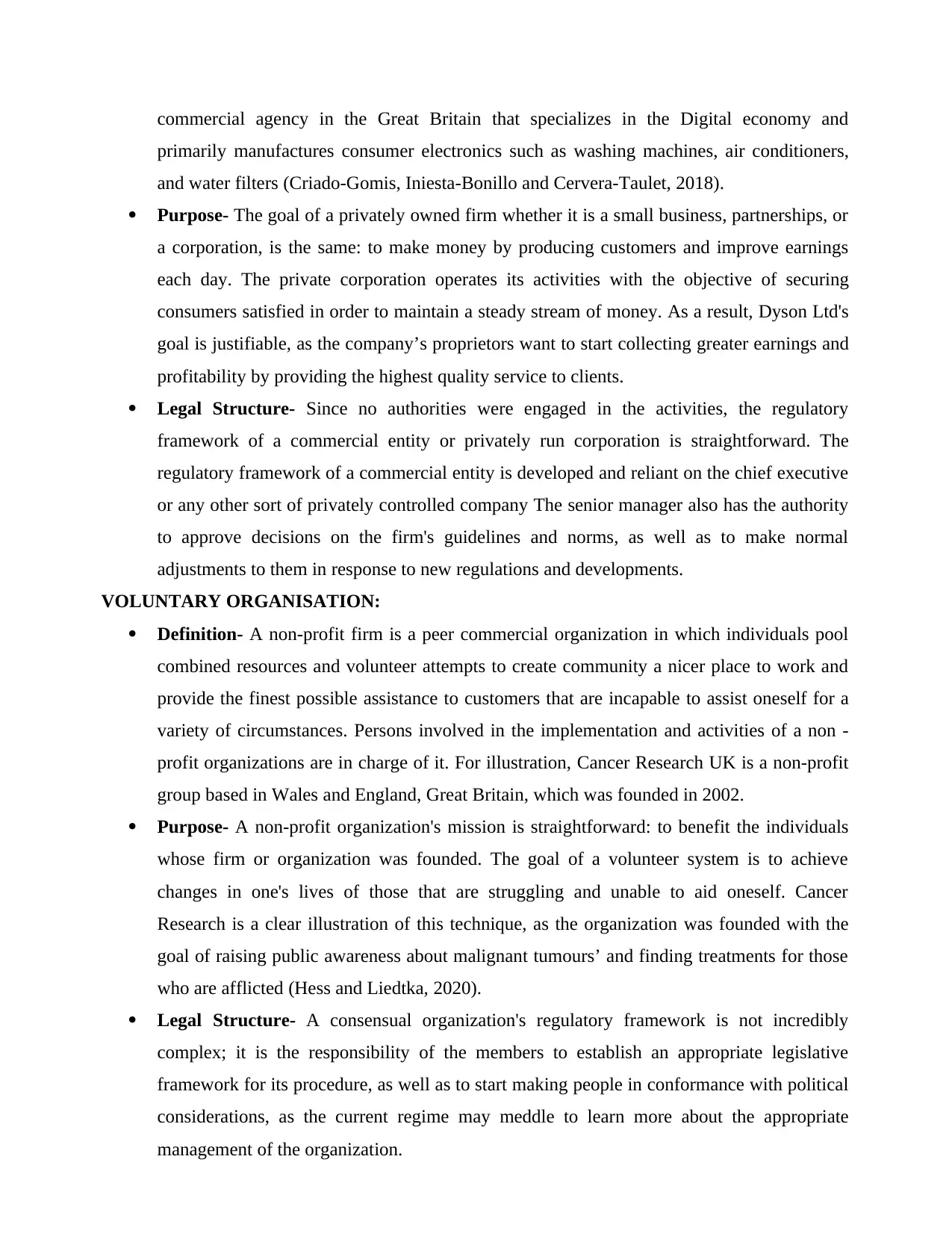
commercial agency in the Great Britain that specializes in the Digital economy and
primarily manufactures consumer electronics such as washing machines, air conditioners,
and water filters (Criado-Gomis, Iniesta-Bonillo and Cervera-Taulet, 2018).
Purpose- The goal of a privately owned firm whether it is a small business, partnerships, or
a corporation, is the same: to make money by producing customers and improve earnings
each day. The private corporation operates its activities with the objective of securing
consumers satisfied in order to maintain a steady stream of money. As a result, Dyson Ltd's
goal is justifiable, as the company’s proprietors want to start collecting greater earnings and
profitability by providing the highest quality service to clients.
Legal Structure- Since no authorities were engaged in the activities, the regulatory
framework of a commercial entity or privately run corporation is straightforward. The
regulatory framework of a commercial entity is developed and reliant on the chief executive
or any other sort of privately controlled company The senior manager also has the authority
to approve decisions on the firm's guidelines and norms, as well as to make normal
adjustments to them in response to new regulations and developments.
VOLUNTARY ORGANISATION:
Definition- A non-profit firm is a peer commercial organization in which individuals pool
combined resources and volunteer attempts to create community a nicer place to work and
provide the finest possible assistance to customers that are incapable to assist oneself for a
variety of circumstances. Persons involved in the implementation and activities of a non -
profit organizations are in charge of it. For illustration, Cancer Research UK is a non-profit
group based in Wales and England, Great Britain, which was founded in 2002.
Purpose- A non-profit organization's mission is straightforward: to benefit the individuals
whose firm or organization was founded. The goal of a volunteer system is to achieve
changes in one's lives of those that are struggling and unable to aid oneself. Cancer
Research is a clear illustration of this technique, as the organization was founded with the
goal of raising public awareness about malignant tumours’ and finding treatments for those
who are afflicted (Hess and Liedtka, 2020).
Legal Structure- A consensual organization's regulatory framework is not incredibly
complex; it is the responsibility of the members to establish an appropriate legislative
framework for its procedure, as well as to start making people in conformance with political
considerations, as the current regime may meddle to learn more about the appropriate
management of the organization.
primarily manufactures consumer electronics such as washing machines, air conditioners,
and water filters (Criado-Gomis, Iniesta-Bonillo and Cervera-Taulet, 2018).
Purpose- The goal of a privately owned firm whether it is a small business, partnerships, or
a corporation, is the same: to make money by producing customers and improve earnings
each day. The private corporation operates its activities with the objective of securing
consumers satisfied in order to maintain a steady stream of money. As a result, Dyson Ltd's
goal is justifiable, as the company’s proprietors want to start collecting greater earnings and
profitability by providing the highest quality service to clients.
Legal Structure- Since no authorities were engaged in the activities, the regulatory
framework of a commercial entity or privately run corporation is straightforward. The
regulatory framework of a commercial entity is developed and reliant on the chief executive
or any other sort of privately controlled company The senior manager also has the authority
to approve decisions on the firm's guidelines and norms, as well as to make normal
adjustments to them in response to new regulations and developments.
VOLUNTARY ORGANISATION:
Definition- A non-profit firm is a peer commercial organization in which individuals pool
combined resources and volunteer attempts to create community a nicer place to work and
provide the finest possible assistance to customers that are incapable to assist oneself for a
variety of circumstances. Persons involved in the implementation and activities of a non -
profit organizations are in charge of it. For illustration, Cancer Research UK is a non-profit
group based in Wales and England, Great Britain, which was founded in 2002.
Purpose- A non-profit organization's mission is straightforward: to benefit the individuals
whose firm or organization was founded. The goal of a volunteer system is to achieve
changes in one's lives of those that are struggling and unable to aid oneself. Cancer
Research is a clear illustration of this technique, as the organization was founded with the
goal of raising public awareness about malignant tumours’ and finding treatments for those
who are afflicted (Hess and Liedtka, 2020).
Legal Structure- A consensual organization's regulatory framework is not incredibly
complex; it is the responsibility of the members to establish an appropriate legislative
framework for its procedure, as well as to start making people in conformance with political
considerations, as the current regime may meddle to learn more about the appropriate
management of the organization.
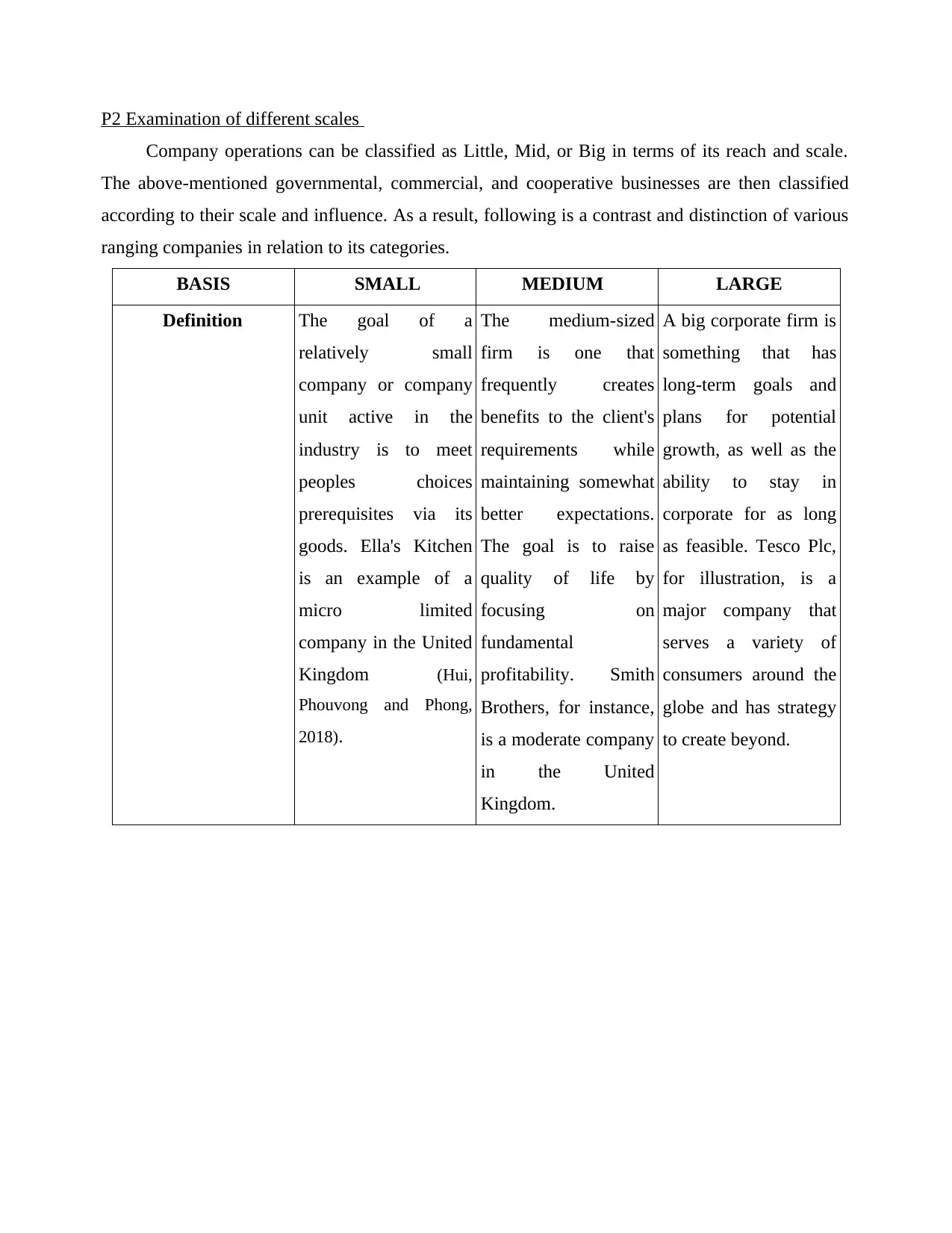
P2 Examination of different scales
Company operations can be classified as Little, Mid, or Big in terms of its reach and scale.
The above-mentioned governmental, commercial, and cooperative businesses are then classified
according to their scale and influence. As a result, following is a contrast and distinction of various
ranging companies in relation to its categories.
BASIS SMALL MEDIUM LARGE
Definition The goal of a
relatively small
company or company
unit active in the
industry is to meet
peoples choices
prerequisites via its
goods. Ella's Kitchen
is an example of a
micro limited
company in the United
Kingdom (Hui,
Phouvong and Phong,
2018).
The medium-sized
firm is one that
frequently creates
benefits to the client's
requirements while
maintaining somewhat
better expectations.
The goal is to raise
quality of life by
focusing on
fundamental
profitability. Smith
Brothers, for instance,
is a moderate company
in the United
Kingdom.
A big corporate firm is
something that has
long-term goals and
plans for potential
growth, as well as the
ability to stay in
corporate for as long
as feasible. Tesco Plc,
for illustration, is a
major company that
serves a variety of
consumers around the
globe and has strategy
to create beyond.
Company operations can be classified as Little, Mid, or Big in terms of its reach and scale.
The above-mentioned governmental, commercial, and cooperative businesses are then classified
according to their scale and influence. As a result, following is a contrast and distinction of various
ranging companies in relation to its categories.
BASIS SMALL MEDIUM LARGE
Definition The goal of a
relatively small
company or company
unit active in the
industry is to meet
peoples choices
prerequisites via its
goods. Ella's Kitchen
is an example of a
micro limited
company in the United
Kingdom (Hui,
Phouvong and Phong,
2018).
The medium-sized
firm is one that
frequently creates
benefits to the client's
requirements while
maintaining somewhat
better expectations.
The goal is to raise
quality of life by
focusing on
fundamental
profitability. Smith
Brothers, for instance,
is a moderate company
in the United
Kingdom.
A big corporate firm is
something that has
long-term goals and
plans for potential
growth, as well as the
ability to stay in
corporate for as long
as feasible. Tesco Plc,
for illustration, is a
major company that
serves a variety of
consumers around the
globe and has strategy
to create beyond.
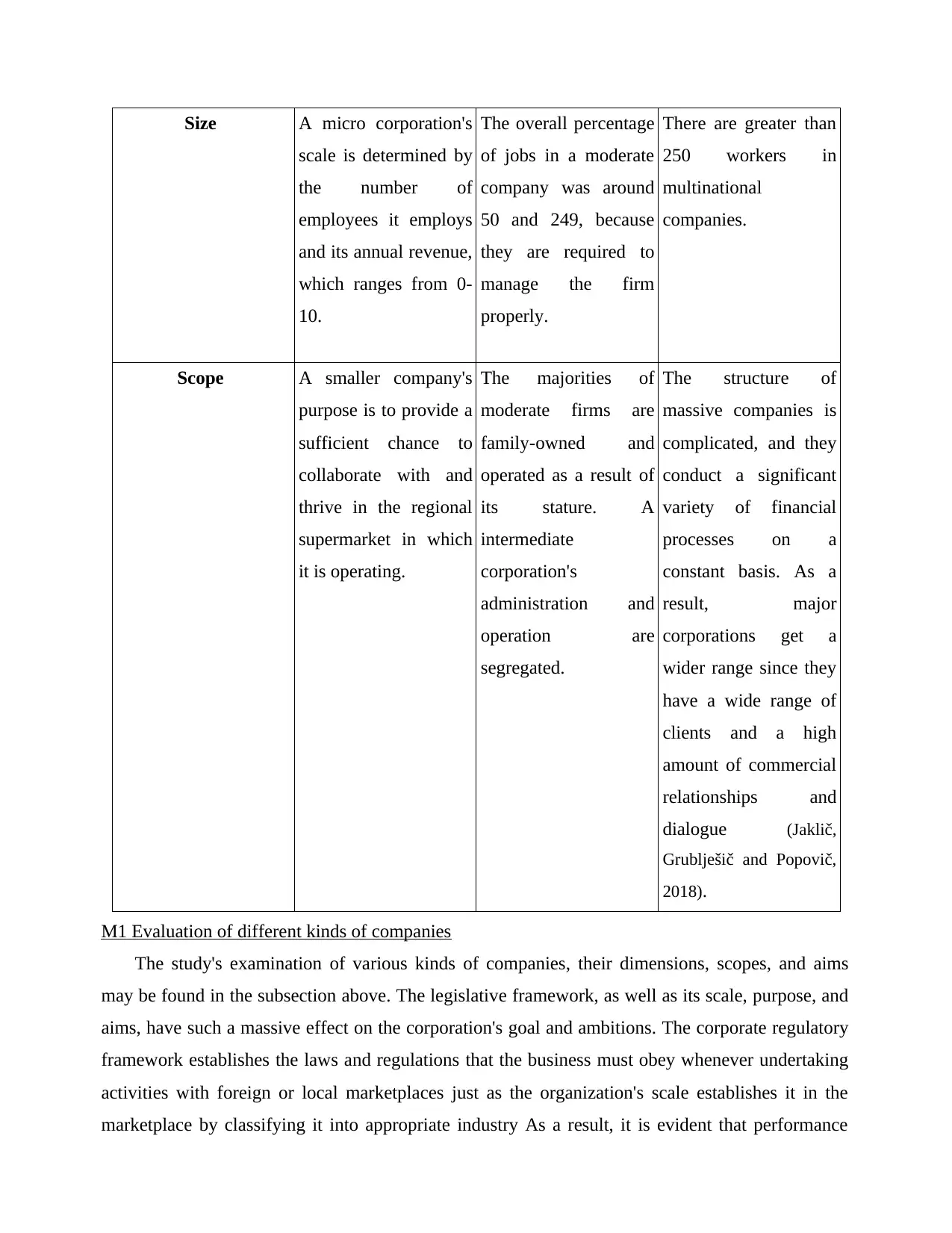
Size A micro corporation's
scale is determined by
the number of
employees it employs
and its annual revenue,
which ranges from 0-
10.
The overall percentage
of jobs in a moderate
company was around
50 and 249, because
they are required to
manage the firm
properly.
There are greater than
250 workers in
multinational
companies.
Scope A smaller company's
purpose is to provide a
sufficient chance to
collaborate with and
thrive in the regional
supermarket in which
it is operating.
The majorities of
moderate firms are
family-owned and
operated as a result of
its stature. A
intermediate
corporation's
administration and
operation are
segregated.
The structure of
massive companies is
complicated, and they
conduct a significant
variety of financial
processes on a
constant basis. As a
result, major
corporations get a
wider range since they
have a wide range of
clients and a high
amount of commercial
relationships and
dialogue (Jaklič,
Grublješič and Popovič,
2018).
M1 Evaluation of different kinds of companies
The study's examination of various kinds of companies, their dimensions, scopes, and aims
may be found in the subsection above. The legislative framework, as well as its scale, purpose, and
aims, have such a massive effect on the corporation's goal and ambitions. The corporate regulatory
framework establishes the laws and regulations that the business must obey whenever undertaking
activities with foreign or local marketplaces just as the organization's scale establishes it in the
marketplace by classifying it into appropriate industry As a result, it is evident that performance
scale is determined by
the number of
employees it employs
and its annual revenue,
which ranges from 0-
10.
The overall percentage
of jobs in a moderate
company was around
50 and 249, because
they are required to
manage the firm
properly.
There are greater than
250 workers in
multinational
companies.
Scope A smaller company's
purpose is to provide a
sufficient chance to
collaborate with and
thrive in the regional
supermarket in which
it is operating.
The majorities of
moderate firms are
family-owned and
operated as a result of
its stature. A
intermediate
corporation's
administration and
operation are
segregated.
The structure of
massive companies is
complicated, and they
conduct a significant
variety of financial
processes on a
constant basis. As a
result, major
corporations get a
wider range since they
have a wide range of
clients and a high
amount of commercial
relationships and
dialogue (Jaklič,
Grublješič and Popovič,
2018).
M1 Evaluation of different kinds of companies
The study's examination of various kinds of companies, their dimensions, scopes, and aims
may be found in the subsection above. The legislative framework, as well as its scale, purpose, and
aims, have such a massive effect on the corporation's goal and ambitions. The corporate regulatory
framework establishes the laws and regulations that the business must obey whenever undertaking
activities with foreign or local marketplaces just as the organization's scale establishes it in the
marketplace by classifying it into appropriate industry As a result, it is evident that performance
Paraphrase This Document
Need a fresh take? Get an instant paraphrase of this document with our AI Paraphraser
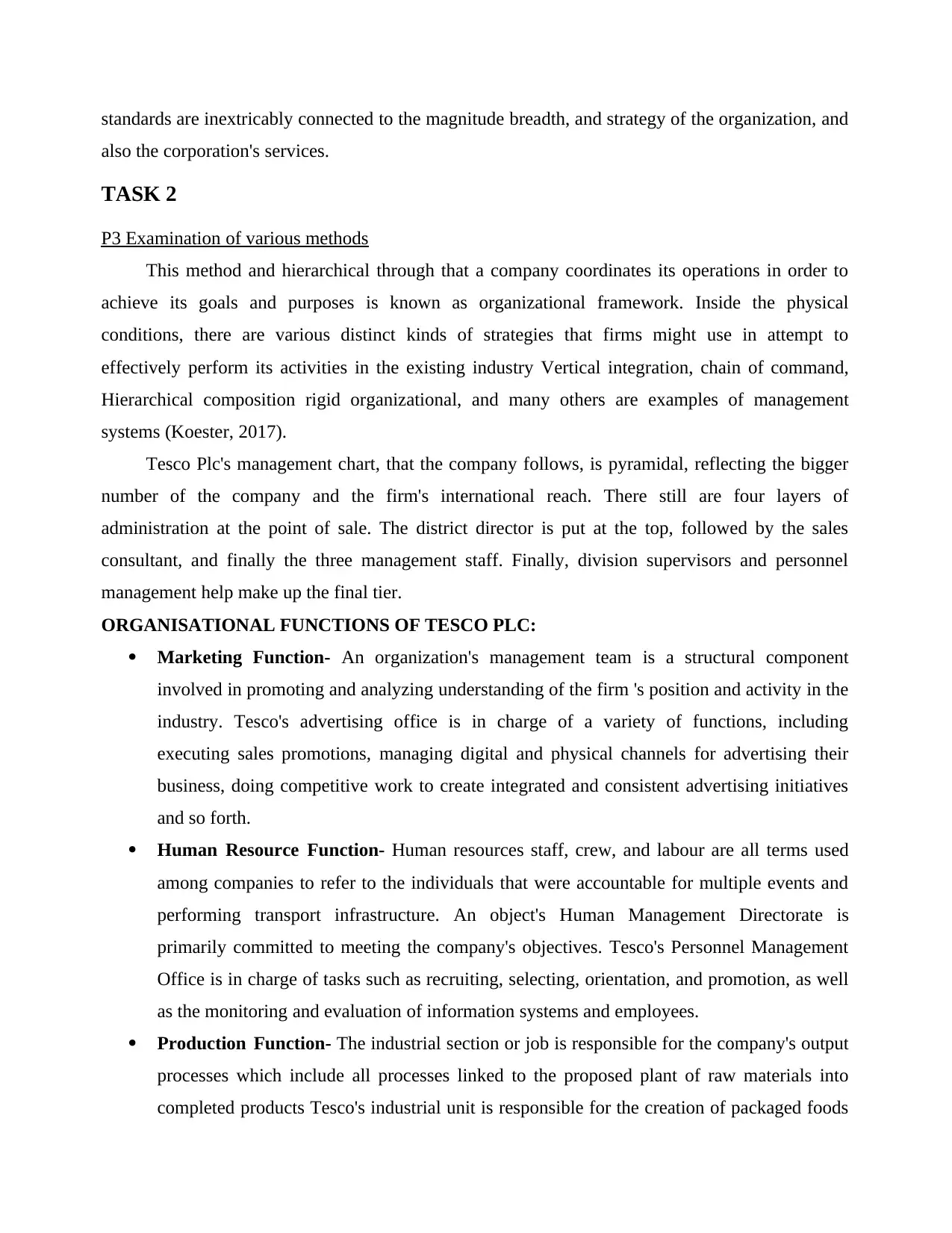
standards are inextricably connected to the magnitude breadth, and strategy of the organization, and
also the corporation's services.
TASK 2
P3 Examination of various methods
This method and hierarchical through that a company coordinates its operations in order to
achieve its goals and purposes is known as organizational framework. Inside the physical
conditions, there are various distinct kinds of strategies that firms might use in attempt to
effectively perform its activities in the existing industry Vertical integration, chain of command,
Hierarchical composition rigid organizational, and many others are examples of management
systems (Koester, 2017).
Tesco Plc's management chart, that the company follows, is pyramidal, reflecting the bigger
number of the company and the firm's international reach. There still are four layers of
administration at the point of sale. The district director is put at the top, followed by the sales
consultant, and finally the three management staff. Finally, division supervisors and personnel
management help make up the final tier.
ORGANISATIONAL FUNCTIONS OF TESCO PLC:
Marketing Function- An organization's management team is a structural component
involved in promoting and analyzing understanding of the firm 's position and activity in the
industry. Tesco's advertising office is in charge of a variety of functions, including
executing sales promotions, managing digital and physical channels for advertising their
business, doing competitive work to create integrated and consistent advertising initiatives
and so forth.
Human Resource Function- Human resources staff, crew, and labour are all terms used
among companies to refer to the individuals that were accountable for multiple events and
performing transport infrastructure. An object's Human Management Directorate is
primarily committed to meeting the company's objectives. Tesco's Personnel Management
Office is in charge of tasks such as recruiting, selecting, orientation, and promotion, as well
as the monitoring and evaluation of information systems and employees.
Production Function- The industrial section or job is responsible for the company's output
processes which include all processes linked to the proposed plant of raw materials into
completed products Tesco's industrial unit is responsible for the creation of packaged foods
also the corporation's services.
TASK 2
P3 Examination of various methods
This method and hierarchical through that a company coordinates its operations in order to
achieve its goals and purposes is known as organizational framework. Inside the physical
conditions, there are various distinct kinds of strategies that firms might use in attempt to
effectively perform its activities in the existing industry Vertical integration, chain of command,
Hierarchical composition rigid organizational, and many others are examples of management
systems (Koester, 2017).
Tesco Plc's management chart, that the company follows, is pyramidal, reflecting the bigger
number of the company and the firm's international reach. There still are four layers of
administration at the point of sale. The district director is put at the top, followed by the sales
consultant, and finally the three management staff. Finally, division supervisors and personnel
management help make up the final tier.
ORGANISATIONAL FUNCTIONS OF TESCO PLC:
Marketing Function- An organization's management team is a structural component
involved in promoting and analyzing understanding of the firm 's position and activity in the
industry. Tesco's advertising office is in charge of a variety of functions, including
executing sales promotions, managing digital and physical channels for advertising their
business, doing competitive work to create integrated and consistent advertising initiatives
and so forth.
Human Resource Function- Human resources staff, crew, and labour are all terms used
among companies to refer to the individuals that were accountable for multiple events and
performing transport infrastructure. An object's Human Management Directorate is
primarily committed to meeting the company's objectives. Tesco's Personnel Management
Office is in charge of tasks such as recruiting, selecting, orientation, and promotion, as well
as the monitoring and evaluation of information systems and employees.
Production Function- The industrial section or job is responsible for the company's output
processes which include all processes linked to the proposed plant of raw materials into
completed products Tesco's industrial unit is responsible for the creation of packaged foods
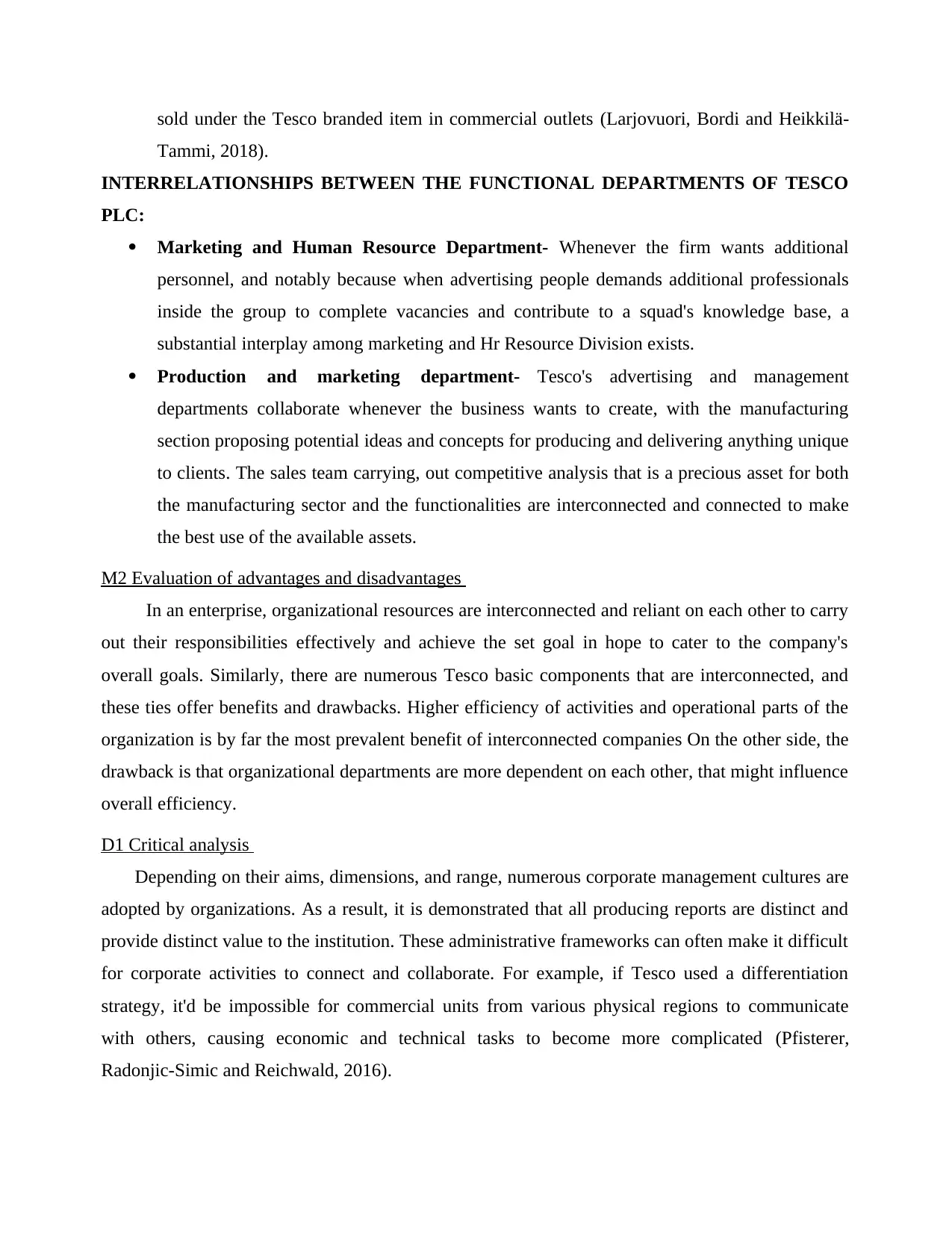
sold under the Tesco branded item in commercial outlets (Larjovuori, Bordi and Heikkilä-
Tammi, 2018).
INTERRELATIONSHIPS BETWEEN THE FUNCTIONAL DEPARTMENTS OF TESCO
PLC:
Marketing and Human Resource Department- Whenever the firm wants additional
personnel, and notably because when advertising people demands additional professionals
inside the group to complete vacancies and contribute to a squad's knowledge base, a
substantial interplay among marketing and Hr Resource Division exists.
Production and marketing department- Tesco's advertising and management
departments collaborate whenever the business wants to create, with the manufacturing
section proposing potential ideas and concepts for producing and delivering anything unique
to clients. The sales team carrying, out competitive analysis that is a precious asset for both
the manufacturing sector and the functionalities are interconnected and connected to make
the best use of the available assets.
M2 Evaluation of advantages and disadvantages
In an enterprise, organizational resources are interconnected and reliant on each other to carry
out their responsibilities effectively and achieve the set goal in hope to cater to the company's
overall goals. Similarly, there are numerous Tesco basic components that are interconnected, and
these ties offer benefits and drawbacks. Higher efficiency of activities and operational parts of the
organization is by far the most prevalent benefit of interconnected companies On the other side, the
drawback is that organizational departments are more dependent on each other, that might influence
overall efficiency.
D1 Critical analysis
Depending on their aims, dimensions, and range, numerous corporate management cultures are
adopted by organizations. As a result, it is demonstrated that all producing reports are distinct and
provide distinct value to the institution. These administrative frameworks can often make it difficult
for corporate activities to connect and collaborate. For example, if Tesco used a differentiation
strategy, it'd be impossible for commercial units from various physical regions to communicate
with others, causing economic and technical tasks to become more complicated (Pfisterer,
Radonjic-Simic and Reichwald, 2016).
Tammi, 2018).
INTERRELATIONSHIPS BETWEEN THE FUNCTIONAL DEPARTMENTS OF TESCO
PLC:
Marketing and Human Resource Department- Whenever the firm wants additional
personnel, and notably because when advertising people demands additional professionals
inside the group to complete vacancies and contribute to a squad's knowledge base, a
substantial interplay among marketing and Hr Resource Division exists.
Production and marketing department- Tesco's advertising and management
departments collaborate whenever the business wants to create, with the manufacturing
section proposing potential ideas and concepts for producing and delivering anything unique
to clients. The sales team carrying, out competitive analysis that is a precious asset for both
the manufacturing sector and the functionalities are interconnected and connected to make
the best use of the available assets.
M2 Evaluation of advantages and disadvantages
In an enterprise, organizational resources are interconnected and reliant on each other to carry
out their responsibilities effectively and achieve the set goal in hope to cater to the company's
overall goals. Similarly, there are numerous Tesco basic components that are interconnected, and
these ties offer benefits and drawbacks. Higher efficiency of activities and operational parts of the
organization is by far the most prevalent benefit of interconnected companies On the other side, the
drawback is that organizational departments are more dependent on each other, that might influence
overall efficiency.
D1 Critical analysis
Depending on their aims, dimensions, and range, numerous corporate management cultures are
adopted by organizations. As a result, it is demonstrated that all producing reports are distinct and
provide distinct value to the institution. These administrative frameworks can often make it difficult
for corporate activities to connect and collaborate. For example, if Tesco used a differentiation
strategy, it'd be impossible for commercial units from various physical regions to communicate
with others, causing economic and technical tasks to become more complicated (Pfisterer,
Radonjic-Simic and Reichwald, 2016).
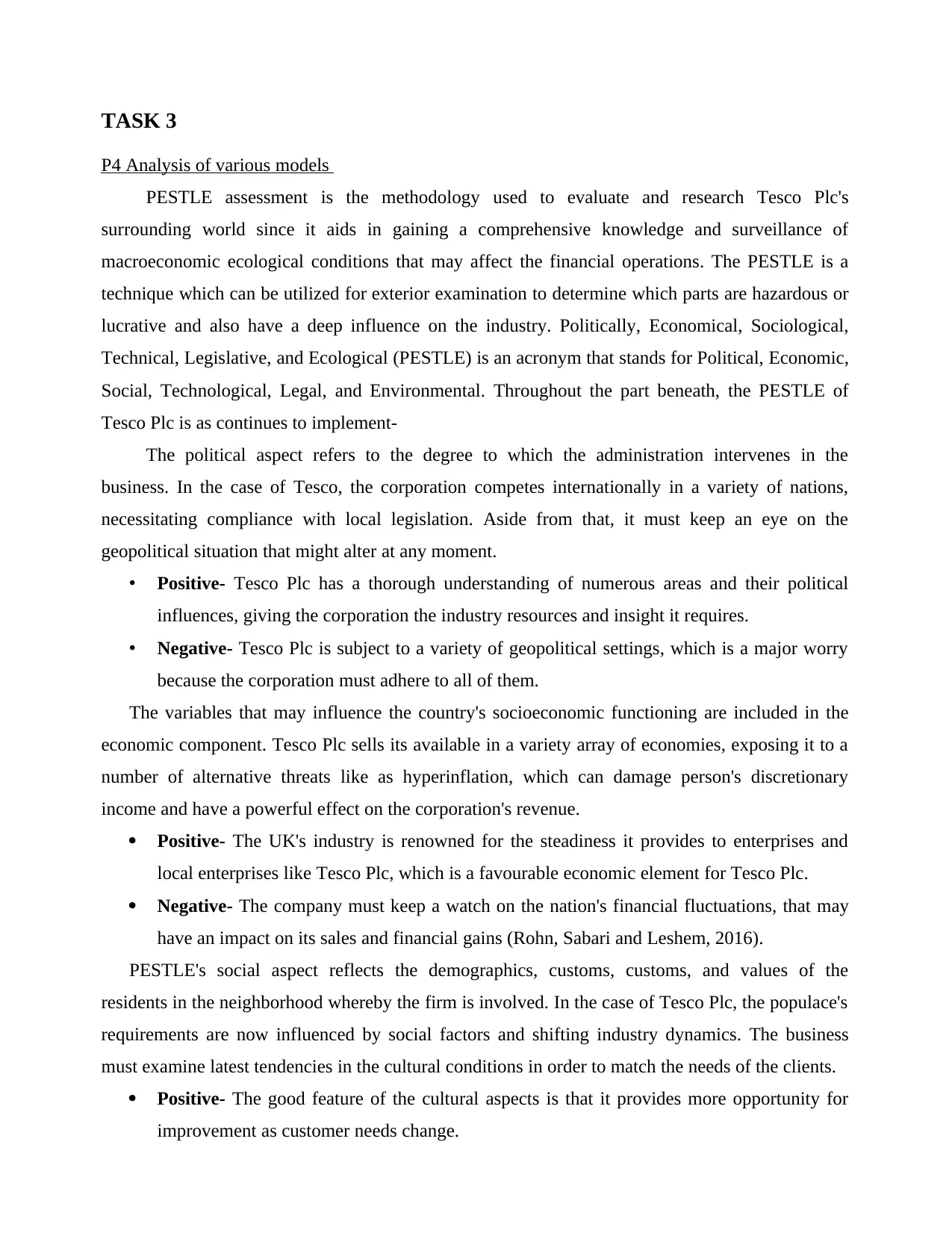
TASK 3
P4 Analysis of various models
PESTLE assessment is the methodology used to evaluate and research Tesco Plc's
surrounding world since it aids in gaining a comprehensive knowledge and surveillance of
macroeconomic ecological conditions that may affect the financial operations. The PESTLE is a
technique which can be utilized for exterior examination to determine which parts are hazardous or
lucrative and also have a deep influence on the industry. Politically, Economical, Sociological,
Technical, Legislative, and Ecological (PESTLE) is an acronym that stands for Political, Economic,
Social, Technological, Legal, and Environmental. Throughout the part beneath, the PESTLE of
Tesco Plc is as continues to implement-
The political aspect refers to the degree to which the administration intervenes in the
business. In the case of Tesco, the corporation competes internationally in a variety of nations,
necessitating compliance with local legislation. Aside from that, it must keep an eye on the
geopolitical situation that might alter at any moment.
• Positive- Tesco Plc has a thorough understanding of numerous areas and their political
influences, giving the corporation the industry resources and insight it requires.
• Negative- Tesco Plc is subject to a variety of geopolitical settings, which is a major worry
because the corporation must adhere to all of them.
The variables that may influence the country's socioeconomic functioning are included in the
economic component. Tesco Plc sells its available in a variety array of economies, exposing it to a
number of alternative threats like as hyperinflation, which can damage person's discretionary
income and have a powerful effect on the corporation's revenue.
Positive- The UK's industry is renowned for the steadiness it provides to enterprises and
local enterprises like Tesco Plc, which is a favourable economic element for Tesco Plc.
Negative- The company must keep a watch on the nation's financial fluctuations, that may
have an impact on its sales and financial gains (Rohn, Sabari and Leshem, 2016).
PESTLE's social aspect reflects the demographics, customs, customs, and values of the
residents in the neighborhood whereby the firm is involved. In the case of Tesco Plc, the populace's
requirements are now influenced by social factors and shifting industry dynamics. The business
must examine latest tendencies in the cultural conditions in order to match the needs of the clients.
Positive- The good feature of the cultural aspects is that it provides more opportunity for
improvement as customer needs change.
P4 Analysis of various models
PESTLE assessment is the methodology used to evaluate and research Tesco Plc's
surrounding world since it aids in gaining a comprehensive knowledge and surveillance of
macroeconomic ecological conditions that may affect the financial operations. The PESTLE is a
technique which can be utilized for exterior examination to determine which parts are hazardous or
lucrative and also have a deep influence on the industry. Politically, Economical, Sociological,
Technical, Legislative, and Ecological (PESTLE) is an acronym that stands for Political, Economic,
Social, Technological, Legal, and Environmental. Throughout the part beneath, the PESTLE of
Tesco Plc is as continues to implement-
The political aspect refers to the degree to which the administration intervenes in the
business. In the case of Tesco, the corporation competes internationally in a variety of nations,
necessitating compliance with local legislation. Aside from that, it must keep an eye on the
geopolitical situation that might alter at any moment.
• Positive- Tesco Plc has a thorough understanding of numerous areas and their political
influences, giving the corporation the industry resources and insight it requires.
• Negative- Tesco Plc is subject to a variety of geopolitical settings, which is a major worry
because the corporation must adhere to all of them.
The variables that may influence the country's socioeconomic functioning are included in the
economic component. Tesco Plc sells its available in a variety array of economies, exposing it to a
number of alternative threats like as hyperinflation, which can damage person's discretionary
income and have a powerful effect on the corporation's revenue.
Positive- The UK's industry is renowned for the steadiness it provides to enterprises and
local enterprises like Tesco Plc, which is a favourable economic element for Tesco Plc.
Negative- The company must keep a watch on the nation's financial fluctuations, that may
have an impact on its sales and financial gains (Rohn, Sabari and Leshem, 2016).
PESTLE's social aspect reflects the demographics, customs, customs, and values of the
residents in the neighborhood whereby the firm is involved. In the case of Tesco Plc, the populace's
requirements are now influenced by social factors and shifting industry dynamics. The business
must examine latest tendencies in the cultural conditions in order to match the needs of the clients.
Positive- The good feature of the cultural aspects is that it provides more opportunity for
improvement as customer needs change.
Secure Best Marks with AI Grader
Need help grading? Try our AI Grader for instant feedback on your assignments.
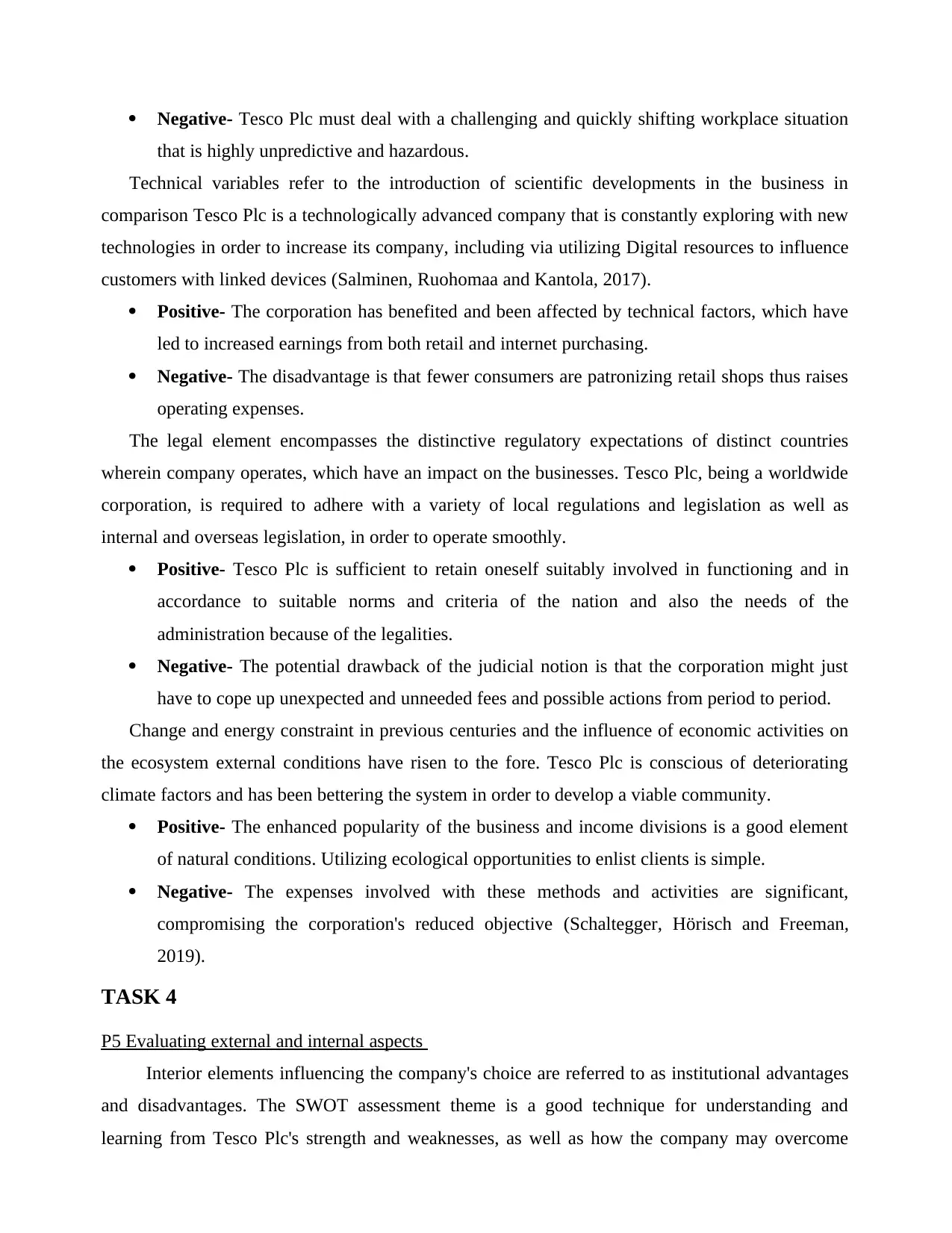
Negative- Tesco Plc must deal with a challenging and quickly shifting workplace situation
that is highly unpredictive and hazardous.
Technical variables refer to the introduction of scientific developments in the business in
comparison Tesco Plc is a technologically advanced company that is constantly exploring with new
technologies in order to increase its company, including via utilizing Digital resources to influence
customers with linked devices (Salminen, Ruohomaa and Kantola, 2017).
Positive- The corporation has benefited and been affected by technical factors, which have
led to increased earnings from both retail and internet purchasing.
Negative- The disadvantage is that fewer consumers are patronizing retail shops thus raises
operating expenses.
The legal element encompasses the distinctive regulatory expectations of distinct countries
wherein company operates, which have an impact on the businesses. Tesco Plc, being a worldwide
corporation, is required to adhere with a variety of local regulations and legislation as well as
internal and overseas legislation, in order to operate smoothly.
Positive- Tesco Plc is sufficient to retain oneself suitably involved in functioning and in
accordance to suitable norms and criteria of the nation and also the needs of the
administration because of the legalities.
Negative- The potential drawback of the judicial notion is that the corporation might just
have to cope up unexpected and unneeded fees and possible actions from period to period.
Change and energy constraint in previous centuries and the influence of economic activities on
the ecosystem external conditions have risen to the fore. Tesco Plc is conscious of deteriorating
climate factors and has been bettering the system in order to develop a viable community.
Positive- The enhanced popularity of the business and income divisions is a good element
of natural conditions. Utilizing ecological opportunities to enlist clients is simple.
Negative- The expenses involved with these methods and activities are significant,
compromising the corporation's reduced objective (Schaltegger, Hörisch and Freeman,
2019).
TASK 4
P5 Evaluating external and internal aspects
Interior elements influencing the company's choice are referred to as institutional advantages
and disadvantages. The SWOT assessment theme is a good technique for understanding and
learning from Tesco Plc's strength and weaknesses, as well as how the company may overcome
that is highly unpredictive and hazardous.
Technical variables refer to the introduction of scientific developments in the business in
comparison Tesco Plc is a technologically advanced company that is constantly exploring with new
technologies in order to increase its company, including via utilizing Digital resources to influence
customers with linked devices (Salminen, Ruohomaa and Kantola, 2017).
Positive- The corporation has benefited and been affected by technical factors, which have
led to increased earnings from both retail and internet purchasing.
Negative- The disadvantage is that fewer consumers are patronizing retail shops thus raises
operating expenses.
The legal element encompasses the distinctive regulatory expectations of distinct countries
wherein company operates, which have an impact on the businesses. Tesco Plc, being a worldwide
corporation, is required to adhere with a variety of local regulations and legislation as well as
internal and overseas legislation, in order to operate smoothly.
Positive- Tesco Plc is sufficient to retain oneself suitably involved in functioning and in
accordance to suitable norms and criteria of the nation and also the needs of the
administration because of the legalities.
Negative- The potential drawback of the judicial notion is that the corporation might just
have to cope up unexpected and unneeded fees and possible actions from period to period.
Change and energy constraint in previous centuries and the influence of economic activities on
the ecosystem external conditions have risen to the fore. Tesco Plc is conscious of deteriorating
climate factors and has been bettering the system in order to develop a viable community.
Positive- The enhanced popularity of the business and income divisions is a good element
of natural conditions. Utilizing ecological opportunities to enlist clients is simple.
Negative- The expenses involved with these methods and activities are significant,
compromising the corporation's reduced objective (Schaltegger, Hörisch and Freeman,
2019).
TASK 4
P5 Evaluating external and internal aspects
Interior elements influencing the company's choice are referred to as institutional advantages
and disadvantages. The SWOT assessment theme is a good technique for understanding and
learning from Tesco Plc's strength and weaknesses, as well as how the company may overcome
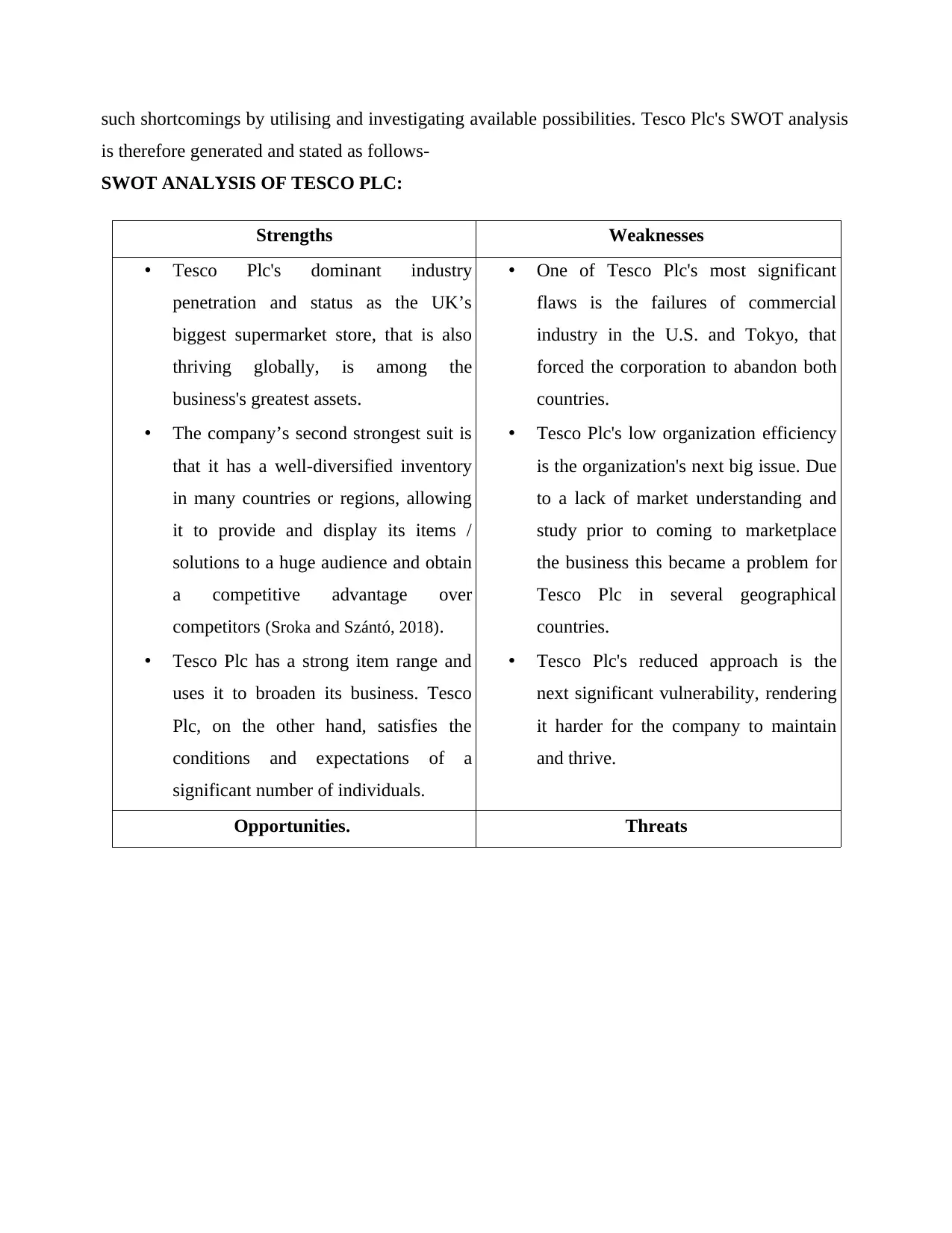
such shortcomings by utilising and investigating available possibilities. Tesco Plc's SWOT analysis
is therefore generated and stated as follows-
SWOT ANALYSIS OF TESCO PLC:
Strengths Weaknesses
• Tesco Plc's dominant industry
penetration and status as the UK’s
biggest supermarket store, that is also
thriving globally, is among the
business's greatest assets.
• The company’s second strongest suit is
that it has a well-diversified inventory
in many countries or regions, allowing
it to provide and display its items /
solutions to a huge audience and obtain
a competitive advantage over
competitors (Sroka and Szántó, 2018).
• Tesco Plc has a strong item range and
uses it to broaden its business. Tesco
Plc, on the other hand, satisfies the
conditions and expectations of a
significant number of individuals.
• One of Tesco Plc's most significant
flaws is the failures of commercial
industry in the U.S. and Tokyo, that
forced the corporation to abandon both
countries.
• Tesco Plc's low organization efficiency
is the organization's next big issue. Due
to a lack of market understanding and
study prior to coming to marketplace
the business this became a problem for
Tesco Plc in several geographical
countries.
• Tesco Plc's reduced approach is the
next significant vulnerability, rendering
it harder for the company to maintain
and thrive.
Opportunities. Threats
is therefore generated and stated as follows-
SWOT ANALYSIS OF TESCO PLC:
Strengths Weaknesses
• Tesco Plc's dominant industry
penetration and status as the UK’s
biggest supermarket store, that is also
thriving globally, is among the
business's greatest assets.
• The company’s second strongest suit is
that it has a well-diversified inventory
in many countries or regions, allowing
it to provide and display its items /
solutions to a huge audience and obtain
a competitive advantage over
competitors (Sroka and Szántó, 2018).
• Tesco Plc has a strong item range and
uses it to broaden its business. Tesco
Plc, on the other hand, satisfies the
conditions and expectations of a
significant number of individuals.
• One of Tesco Plc's most significant
flaws is the failures of commercial
industry in the U.S. and Tokyo, that
forced the corporation to abandon both
countries.
• Tesco Plc's low organization efficiency
is the organization's next big issue. Due
to a lack of market understanding and
study prior to coming to marketplace
the business this became a problem for
Tesco Plc in several geographical
countries.
• Tesco Plc's reduced approach is the
next significant vulnerability, rendering
it harder for the company to maintain
and thrive.
Opportunities. Threats
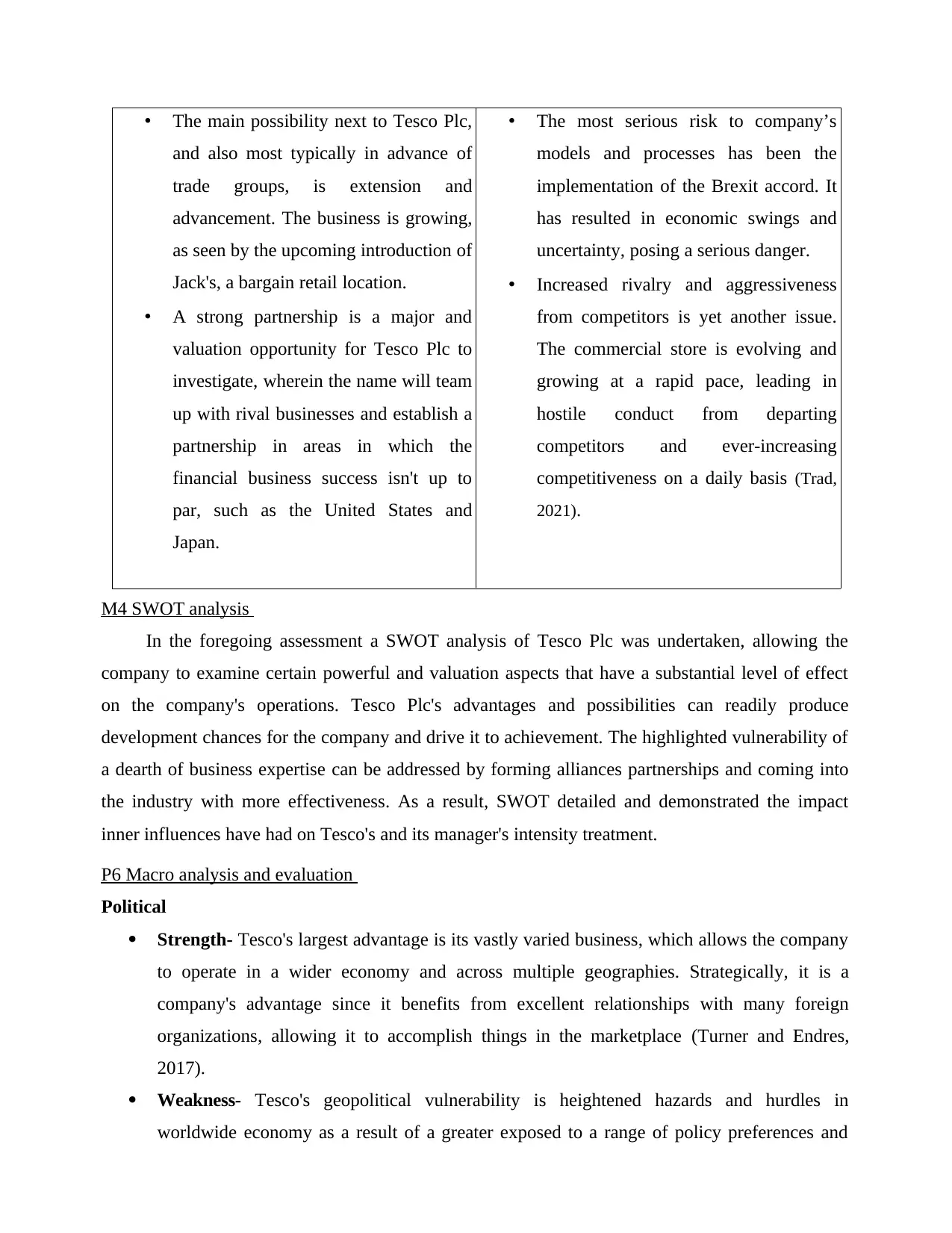
• The main possibility next to Tesco Plc,
and also most typically in advance of
trade groups, is extension and
advancement. The business is growing,
as seen by the upcoming introduction of
Jack's, a bargain retail location.
• A strong partnership is a major and
valuation opportunity for Tesco Plc to
investigate, wherein the name will team
up with rival businesses and establish a
partnership in areas in which the
financial business success isn't up to
par, such as the United States and
Japan.
• The most serious risk to company’s
models and processes has been the
implementation of the Brexit accord. It
has resulted in economic swings and
uncertainty, posing a serious danger.
• Increased rivalry and aggressiveness
from competitors is yet another issue.
The commercial store is evolving and
growing at a rapid pace, leading in
hostile conduct from departing
competitors and ever-increasing
competitiveness on a daily basis (Trad,
2021).
M4 SWOT analysis
In the foregoing assessment a SWOT analysis of Tesco Plc was undertaken, allowing the
company to examine certain powerful and valuation aspects that have a substantial level of effect
on the company's operations. Tesco Plc's advantages and possibilities can readily produce
development chances for the company and drive it to achievement. The highlighted vulnerability of
a dearth of business expertise can be addressed by forming alliances partnerships and coming into
the industry with more effectiveness. As a result, SWOT detailed and demonstrated the impact
inner influences have had on Tesco's and its manager's intensity treatment.
P6 Macro analysis and evaluation
Political
Strength- Tesco's largest advantage is its vastly varied business, which allows the company
to operate in a wider economy and across multiple geographies. Strategically, it is a
company's advantage since it benefits from excellent relationships with many foreign
organizations, allowing it to accomplish things in the marketplace (Turner and Endres,
2017).
Weakness- Tesco's geopolitical vulnerability is heightened hazards and hurdles in
worldwide economy as a result of a greater exposed to a range of policy preferences and
and also most typically in advance of
trade groups, is extension and
advancement. The business is growing,
as seen by the upcoming introduction of
Jack's, a bargain retail location.
• A strong partnership is a major and
valuation opportunity for Tesco Plc to
investigate, wherein the name will team
up with rival businesses and establish a
partnership in areas in which the
financial business success isn't up to
par, such as the United States and
Japan.
• The most serious risk to company’s
models and processes has been the
implementation of the Brexit accord. It
has resulted in economic swings and
uncertainty, posing a serious danger.
• Increased rivalry and aggressiveness
from competitors is yet another issue.
The commercial store is evolving and
growing at a rapid pace, leading in
hostile conduct from departing
competitors and ever-increasing
competitiveness on a daily basis (Trad,
2021).
M4 SWOT analysis
In the foregoing assessment a SWOT analysis of Tesco Plc was undertaken, allowing the
company to examine certain powerful and valuation aspects that have a substantial level of effect
on the company's operations. Tesco Plc's advantages and possibilities can readily produce
development chances for the company and drive it to achievement. The highlighted vulnerability of
a dearth of business expertise can be addressed by forming alliances partnerships and coming into
the industry with more effectiveness. As a result, SWOT detailed and demonstrated the impact
inner influences have had on Tesco's and its manager's intensity treatment.
P6 Macro analysis and evaluation
Political
Strength- Tesco's largest advantage is its vastly varied business, which allows the company
to operate in a wider economy and across multiple geographies. Strategically, it is a
company's advantage since it benefits from excellent relationships with many foreign
organizations, allowing it to accomplish things in the marketplace (Turner and Endres,
2017).
Weakness- Tesco's geopolitical vulnerability is heightened hazards and hurdles in
worldwide economy as a result of a greater exposed to a range of policy preferences and
Paraphrase This Document
Need a fresh take? Get an instant paraphrase of this document with our AI Paraphraser
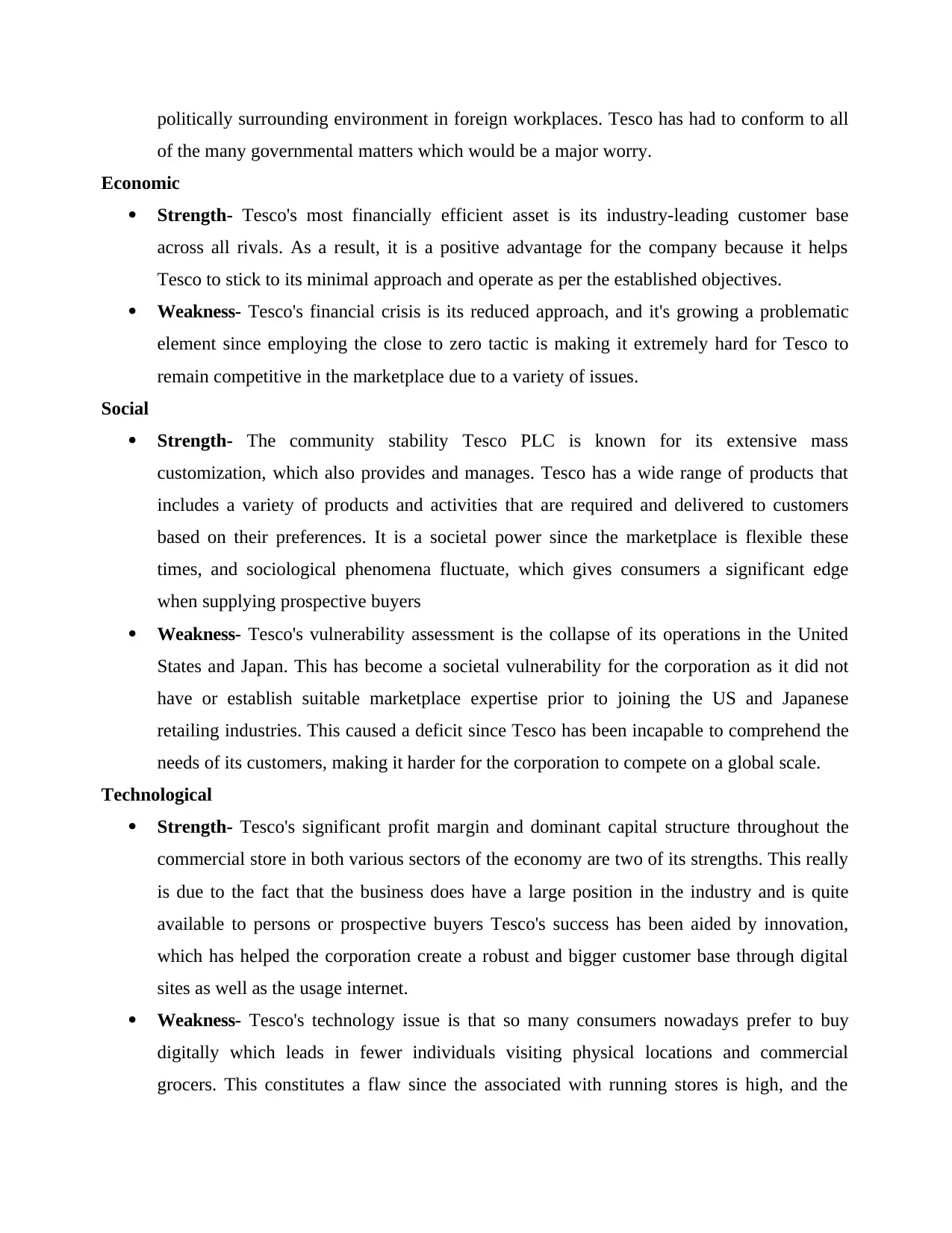
politically surrounding environment in foreign workplaces. Tesco has had to conform to all
of the many governmental matters which would be a major worry.
Economic
Strength- Tesco's most financially efficient asset is its industry-leading customer base
across all rivals. As a result, it is a positive advantage for the company because it helps
Tesco to stick to its minimal approach and operate as per the established objectives.
Weakness- Tesco's financial crisis is its reduced approach, and it's growing a problematic
element since employing the close to zero tactic is making it extremely hard for Tesco to
remain competitive in the marketplace due to a variety of issues.
Social
Strength- The community stability Tesco PLC is known for its extensive mass
customization, which also provides and manages. Tesco has a wide range of products that
includes a variety of products and activities that are required and delivered to customers
based on their preferences. It is a societal power since the marketplace is flexible these
times, and sociological phenomena fluctuate, which gives consumers a significant edge
when supplying prospective buyers
Weakness- Tesco's vulnerability assessment is the collapse of its operations in the United
States and Japan. This has become a societal vulnerability for the corporation as it did not
have or establish suitable marketplace expertise prior to joining the US and Japanese
retailing industries. This caused a deficit since Tesco has been incapable to comprehend the
needs of its customers, making it harder for the corporation to compete on a global scale.
Technological
Strength- Tesco's significant profit margin and dominant capital structure throughout the
commercial store in both various sectors of the economy are two of its strengths. This really
is due to the fact that the business does have a large position in the industry and is quite
available to persons or prospective buyers Tesco's success has been aided by innovation,
which has helped the corporation create a robust and bigger customer base through digital
sites as well as the usage internet.
Weakness- Tesco's technology issue is that so many consumers nowadays prefer to buy
digitally which leads in fewer individuals visiting physical locations and commercial
grocers. This constitutes a flaw since the associated with running stores is high, and the
of the many governmental matters which would be a major worry.
Economic
Strength- Tesco's most financially efficient asset is its industry-leading customer base
across all rivals. As a result, it is a positive advantage for the company because it helps
Tesco to stick to its minimal approach and operate as per the established objectives.
Weakness- Tesco's financial crisis is its reduced approach, and it's growing a problematic
element since employing the close to zero tactic is making it extremely hard for Tesco to
remain competitive in the marketplace due to a variety of issues.
Social
Strength- The community stability Tesco PLC is known for its extensive mass
customization, which also provides and manages. Tesco has a wide range of products that
includes a variety of products and activities that are required and delivered to customers
based on their preferences. It is a societal power since the marketplace is flexible these
times, and sociological phenomena fluctuate, which gives consumers a significant edge
when supplying prospective buyers
Weakness- Tesco's vulnerability assessment is the collapse of its operations in the United
States and Japan. This has become a societal vulnerability for the corporation as it did not
have or establish suitable marketplace expertise prior to joining the US and Japanese
retailing industries. This caused a deficit since Tesco has been incapable to comprehend the
needs of its customers, making it harder for the corporation to compete on a global scale.
Technological
Strength- Tesco's significant profit margin and dominant capital structure throughout the
commercial store in both various sectors of the economy are two of its strengths. This really
is due to the fact that the business does have a large position in the industry and is quite
available to persons or prospective buyers Tesco's success has been aided by innovation,
which has helped the corporation create a robust and bigger customer base through digital
sites as well as the usage internet.
Weakness- Tesco's technology issue is that so many consumers nowadays prefer to buy
digitally which leads in fewer individuals visiting physical locations and commercial
grocers. This constitutes a flaw since the associated with running stores is high, and the
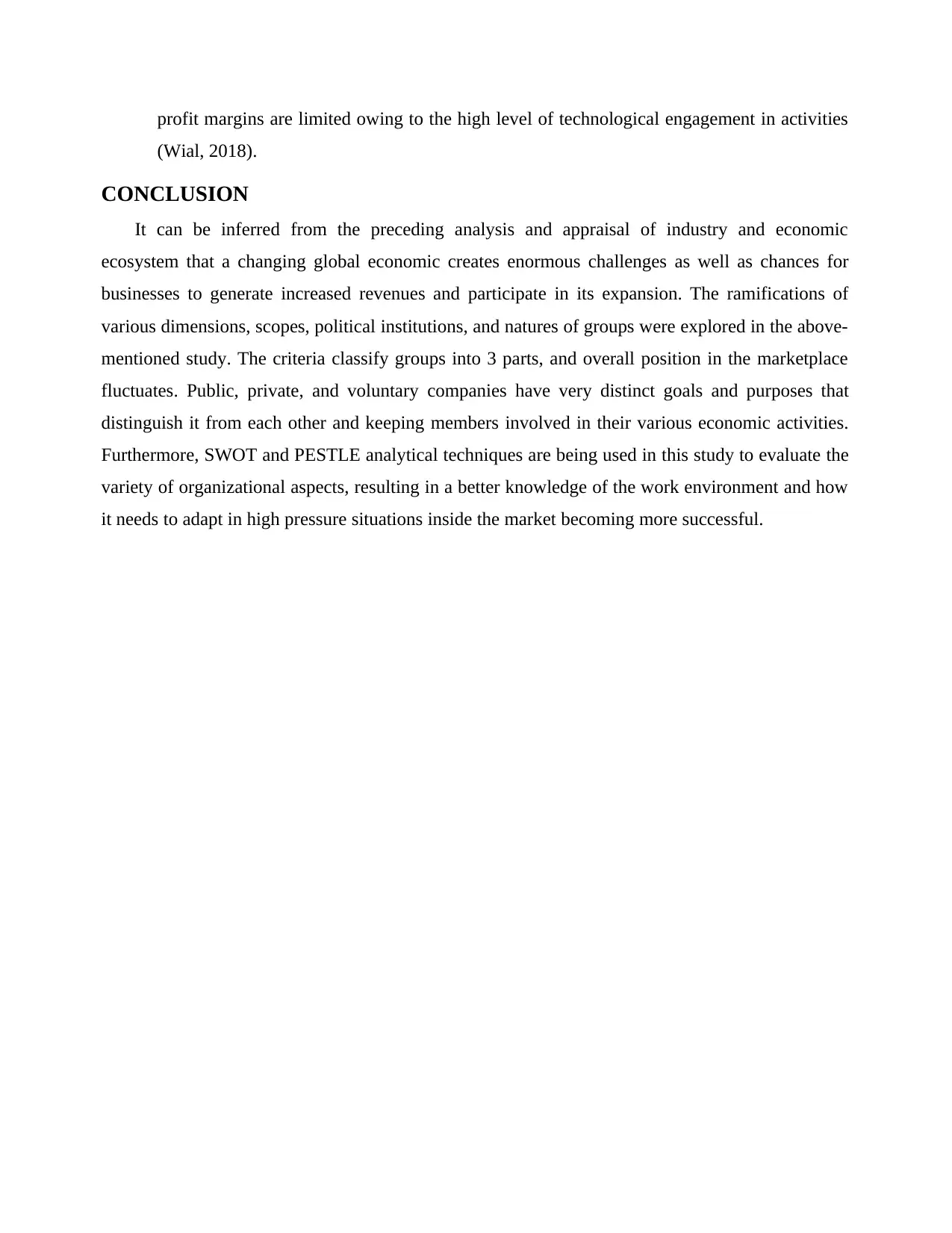
profit margins are limited owing to the high level of technological engagement in activities
(Wial, 2018).
CONCLUSION
It can be inferred from the preceding analysis and appraisal of industry and economic
ecosystem that a changing global economic creates enormous challenges as well as chances for
businesses to generate increased revenues and participate in its expansion. The ramifications of
various dimensions, scopes, political institutions, and natures of groups were explored in the above-
mentioned study. The criteria classify groups into 3 parts, and overall position in the marketplace
fluctuates. Public, private, and voluntary companies have very distinct goals and purposes that
distinguish it from each other and keeping members involved in their various economic activities.
Furthermore, SWOT and PESTLE analytical techniques are being used in this study to evaluate the
variety of organizational aspects, resulting in a better knowledge of the work environment and how
it needs to adapt in high pressure situations inside the market becoming more successful.
(Wial, 2018).
CONCLUSION
It can be inferred from the preceding analysis and appraisal of industry and economic
ecosystem that a changing global economic creates enormous challenges as well as chances for
businesses to generate increased revenues and participate in its expansion. The ramifications of
various dimensions, scopes, political institutions, and natures of groups were explored in the above-
mentioned study. The criteria classify groups into 3 parts, and overall position in the marketplace
fluctuates. Public, private, and voluntary companies have very distinct goals and purposes that
distinguish it from each other and keeping members involved in their various economic activities.
Furthermore, SWOT and PESTLE analytical techniques are being used in this study to evaluate the
variety of organizational aspects, resulting in a better knowledge of the work environment and how
it needs to adapt in high pressure situations inside the market becoming more successful.
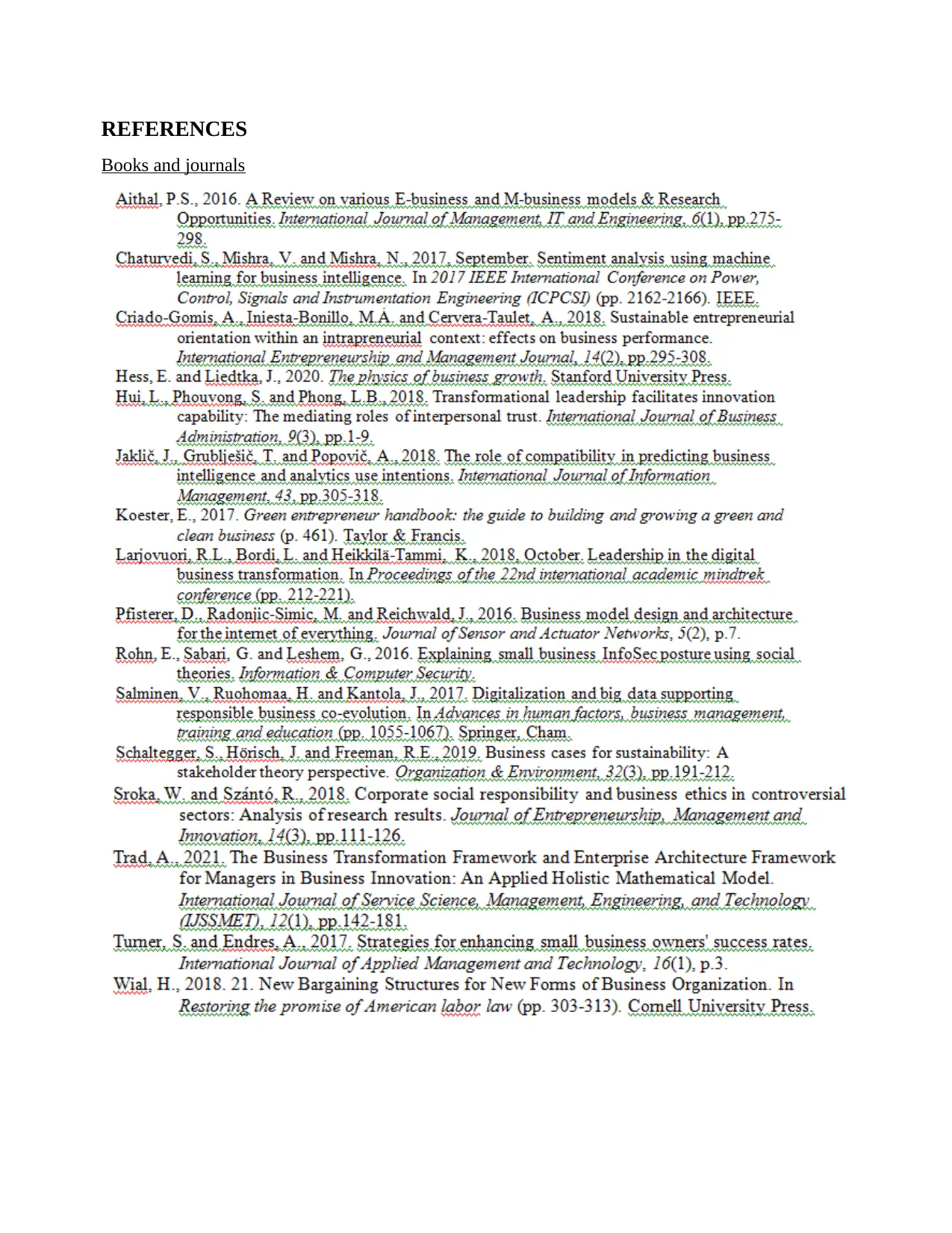
REFERENCES
Books and journals
Books and journals
1 out of 16
Related Documents
Your All-in-One AI-Powered Toolkit for Academic Success.
+13062052269
info@desklib.com
Available 24*7 on WhatsApp / Email
![[object Object]](/_next/static/media/star-bottom.7253800d.svg)
Unlock your academic potential
© 2024 | Zucol Services PVT LTD | All rights reserved.





